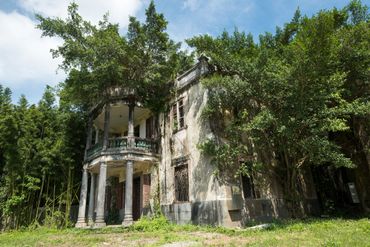Abandoned Mansions
Shek Lo
2 October 2017
Shek Lo was built in 1924 by Peter Tsui Yan-sau, the founder of Wah Yan College. Members of the Tsui family lived there up until the 1980s but it has remained vacant ever since. Peter Tsui passed away in 1981 at the age of 92.




















Yu Yuen
17 October 2015
Built in 1927 by Tsoi Po-tin (1872-1944), a prominent figure in Hong Kong and a leader of the Tsoi clan who settled in Wang Chau, Yuen Long, hundreds of years ago. Tsoi had wished to build a summer villa in Tung Tau Wai, his birthplace, so that his family then living on Hong Kong Island could enjoy the ripe litchi fruit provided by the area all summer long.
Yu Yuen was the private residence of the Tsoi family until 1990. The house featured in a locally produced movie Hong Kong 1941 (1984) starred by Chow Yun-fat, Alex Man and Cecilia Yip. It has been abandoned for some time and is falling into a state of disrepair.






Tao Yuen
13 August 2017
There's been a lease on the land at 13 and 14 Don Bosco Road in Cheung Chau since 11 July 1898. Its last inhabitants were a Tsang family from 1957 to 2000, the proprietor of Tsang Fook Piano Company Limited. The villa and its annex building have been vacant since 2001 and are becoming increasingly dilapidated.
Pun Uk
19 March 2022
Pun Uk, literally Mansion of the Puns, a large traditional Hakka house built by Pun Kwan-min in 1934 to commemorate his father Pun Yum-wah.









64 Kennedy Road
8 July 2017
No. 64 Kennedy Road was the private residence of the Ngan family for decades but equally has been left abandoned for a long time now too. The plot of land was originally owned by Ho Sau-hong who bought the land in 1905. The site was sold in 1924 to a woman named Wong Yik-mui, the wife of Ngan Shing-kwan, a bus tycoon who died in 2001 aged 100.
There is a guard and he won't let you in to have a look around but you can see the garage at street level and the octagonal turret tower looking up from Kennedy Road. There's a good view looking down from Bowen Road where this magnificent old mansion sits in overgrown grounds next to high rise buildings.









Dragon Lodge
15 April 2018
This pre-war mansion at No. 32 Lugard Road on The Peak is said to be Hong Kong’s most haunted house. For decades it was left vacant and decaying, it last changed hands in 2004 for HK$76 million but it's good to see renovation is finally underway. What a place to live, as long as you can get along with the ghost child who cries.
















Marble Hall Gatekeeper's Lodge
11 May 2015
Built as the Gatekeeper’s Lodge of Marble Hall which was the private residence of Sir Paul Chater (1846-1926), a Calcutta-born Armenian merchant of great wealth.
The Gatekeeper’s Lodge was probably built in 1901/1902 when Marble Hall was built but in any case no later than 1918, when it appears in a site plan prepared by the Director of Public Works. Located at a site 500 feet above sea level, Marble Hall was executed in marble specially quarried in Italy and Greece and polished in Belgium. It was regarded as one of the finest buildings ever constructed in Hong Kong.
In May 1946 Marble Hall was devastated by a fire. It stood empty until it was demolished in 1953 to make way for redevelopment, leaving the Gatekeeper’s Lodge as the only reminder of Chater’s residence.
Shortly after World War II, the Gatekeeper’s Lodge was leased to the Royal Interocean Lines. Later on, the Government took it over and used it as government staff quarters. Before 2000, it was used by the now-defunct Urban Services Department (USD) as staff quarters. It was called “Marble Hall USD Staff Quarters” in the 1990s, then “Chater Hall Gardener’s Quarters”. Until recent times, the building has been partially used for storage by landscape staff and partially vacant. Nowadays, it is totally vacant.















Mo's Old House
26 April 2015
Po Toi Island is south of Hong Kong Island with a small population. Most of the villagers subsisted on farming, fishing and the harvesting of sea-weed. Over the past few decades, the island’s population has fallen dramatically as the younger generation began to move away and seek employment in the city.
Mo’s Old House is in Chang Shek Pai. It was built on the site of an original Mo house that was built soon after the Mos came to the island from Huiyang of Guangdong province about one hundred years ago. Mo’s Old House was built in the 1930s by Mo Siu-tong who was said to be an orphan. Mo Siu-tong left the island in his teenage years and worked in the urban area for 20 years. He returned to the island in 1933 and built what is now known as Mo’s Old House, intending to establish a permanent home for retirement. However, after an attempted collusive kidnap by pirates and his maid during the Japanese Occupation (1941-45), he fled the island and left the house to an old housekeeper, never returning again. The house has been left vacant after the death of the housekeeper about fifty years ago.























